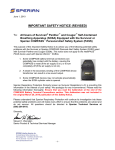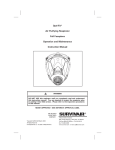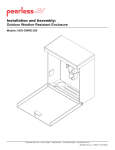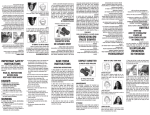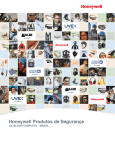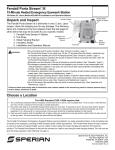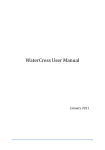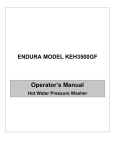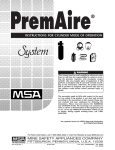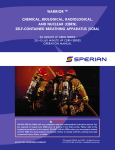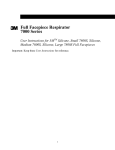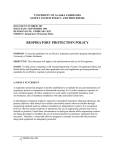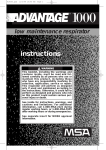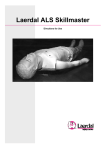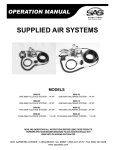Download Respiratory Protection Plan - Wappingers Central School District
Transcript
1 Wappingers Central School District REVISED on May 16, 2012 RESPIRATORY PROTECTION PLAN TABLE OF CONTENTS Purpose of the Program Policy & Procedures I. Administration II. Employee Training Program III. Medical Evaluations IV. Fitting of Respirators V. Selection and Use of Respiratory Protection Equipment VI. Availability VII. Employee Responsibilties A. General B. Cleaning and Disinfecting Respirators C. Routine Inspection of Respirators D. Respirator Storage E. Fit Evaluation prior to use VIII. Respirator Program Evaluation and Record Keeping GLOSSARY Appendix A: Required Training Guide for Respirator Users Appendix B: Annual Respirator Wearer Health Survey Appendix B2: OSHA Respirator/N-95 Medical Evaluation Questionaire Appendix C: Sperian Premier Plus Manufacturer Brochure Appendix D: Sperian Premier Plus Donning & Care Instructions Appendix E: OSHA Respirator Cleaning Procedure Appendix F: OSHA User Seal Check Procedures Appendix H: Employee Acknowledge of Respiratory Protection Program 2 Wappingers Central School District REVISED on May 16, 2012 Wappingers Central School District RESPIRATORY PROTECTION PROGRAM PURPOSE OF THE PROGRAM The purpose of this written respiratory program is to define the Wappingers Central School District’s policy and procedures regarding the use of respirators and to comply with the General Industry Safety Orders, Title 8, Section 5144 (Respiratory Protection). Employees who wear respirators are required to read and understand this Respiratory Protection Program. The program outlines the responsibilities of both the District and those employees required to wear respiratory protection to perform their work safely. To ensure the availability of this written Respiratory Program, copies shall be distributed as follows: * * * * * All Supervisors who have personnel required to use respiratory protection in the course of their employment. Employees using respiratory protection during training and as requested. Representatives of the Health & Safety committee In main office of each school and the transportations offices Upon request. POLICY & PROCEDURES I. ADMINISTRATION The Director of the Health & Safety department shall administer the Respiratory Protection Program. Questions regarding elements of this program and employee protection shall be directed to the Health & Safety office located in the Facilities & Operations office at the RCK Annex, 99 Meyers Corners Rd., Wappingers Falls NY 12590. 3 II. EMPLOYEE TRAINING PROGRAM A. Per OSHA CR 1910.134(K)(1), Each employee designated by the District to wear a respirator must receive initial training and annual refresher training. Training sessions will be provided by a competent person to ensure that employees understand the limitations, use and maintenance of respiratory equipment. See Appendix A for further details on training. B. Each division shall maintain training records. These records must be readily available to representatives of the Health & Safety office. All employees shall receive training prior to being issued and/or wearing a respirator. Wappingers Central School District REVISED on May 16, 2012 III. MEDICAL EVALUATIONS Prior to initially being issued a respirator, all employees shall be medically evaluated. Persons with physical disabilities such as, but not limited to, respiratory impairments, or claustrophobia when wearing a respirator, shall not be assigned to tasks requiring the use of respirators unless it has been determined by a qualified physician that they are physically able to perform work and use the equipment. All respirator users' medical status will be reviewed annually. Employees are required to notify their Supervisors immediately of any health problems that would necessitate a reevaluation of their ability to wear respiratory protection. This information is required to be brought to the Program Administrator’s attention immediately. All employees will fill out the Respirator Wearer Health Survey (see Appendix B) annually, provided by The WorkPlace, to determine the need for a medical evaluation. If medical evaluation is needed, it will be scheduled at The WorkPlace in Poughkeepsie NY. If no medical evaluation is deemed necessary, the employee will be scheduled for an annual fit test. Per OSHA CR 1910.134(e)(7), Additional medical evaluations. At a minimum, the employer shall provide additional medical evaluations that comply with the requirements of this section if: - An employee reports medical signs or symptoms that are related to ability to use a respirator; - A PLHCP, supervisor, or the respirator program administrator informs the employer that an employee needs to be reevaluated; - Information from the respiratory protection program, including observations made during fit testing and program evaluation, indicates a need for employee reevaluation; or - A change occurs in workplace conditions (e.g., physical work effort, protective clothing, temperature) that may result in a substantial increase in the physiological burden placed on an employee. 4 IV. FITTING OF RESPIRATORS A. Proper fitting of respirators is essential and required in order to provide protection for the employee. Prior to being issued and/or wearing a negative pressure respirator, the employee shall be individually fitted for size, comfort and special conditions (eyeglasses, facial scars, welding applications, etc.) at The WorkPlace in Poughkeepsie NY. If employee has previously been fitted and issued a respirator by a district representatives, said employee must bring the issued respirator to annual fit test appointment. B. Fit testing can be arranged through the Health and Safety office. C. There are two ways of fit testing, qualitative (pass/fail) and quantitative (measuring the levels within the mask). Fit tests may be either quantitative or qualitative, performed in accordance with State Law. The WorkPlace uses the Quantitative procedure for fit testing. D. All records pertaining to fit test are on file at the Health & Safety office. Wappingers Central School District REVISED on May 16, 2012 E. Employees who wear negative pressure respirators shall perform both a positive and negative pressure fit test each time the respirator is worn. The procedures for these tests are included with this written program. F. Employees who wear respirators shall contact their Supervisors to arrange for a refitting evaluation when the following occur: significant weight loss or gain; beards or mustaches are grown; eye glasses are required; dental changes affect mouth piece seal; scars or broken bones which change facial conformation; or any other occurrences which may affect the respirator to face seal. G. Employees have been issued a NIOSH approved, Sperian Premier Plus Half Mask, T-Series with P100 Particulate Filters. See Appendix C for details on respirator. V. SELECTION AND USE OF RESPIRATORY PROTECTION EQUIPMENT A. Respirators shall be approved by the Mine Safety and Health Administration (MSHA) or the National Institute for Occupational Safety and Health (NIOSH). B. Selection is dependent upon the type and level of airborne contaminant present, the hazardous operation performed and on the basis of comfort, proper individual fit and protection factor provided. This determination will be made by The WorkPlace based on the employees answers on the OSHA 1910.134 App C – Respirator/N-95 Medical Evaluation Questionaire (see Appendix B2), medical evaluation and fit test. C. Individually owned respirators are prohibited. D. Questions regarding the type of respirator to use for a specific operation shall be directed to the Health & Safety office. E. Respirator users shall not be allowed to wear contact lenses if the risk of eye damage is increased by their use. If a spectacle, goggle, face shield or welding helmet must be worn with a facepiece, it shall be worn so as not to adversely affect the seal of the facepiece to the face. VI. AVAILABILITY Each employee who needs or is required to wear a respirator will be issued one. Consideration will be given to standardizing the brand of respirators utilized. Utilizing different parts (cartridges, filters, valves, etc.) of other makes of respirators voids the certification by the manufacturer. A supply of parts will be available to respirator wearers for replacement and repair. 5 Wappingers Central School District REVISED on May 16, 2012 VII. EMPLOYEE RESPONSIBILITIES A. GENERAL Employees are expected to properly use respiratory protection when and as required; clean and disinfect the units; change filters as required; inspect units for damage or malfunction; check the fit via positive and negative pressure tests prior to use; and provide sanitary storage. Employees shall be completely familiar with the manufacturer's written instructions – see Appendix D. B. CLEANING AND DISINFECTING RESPIRATORS Whenever possible, a respirator will be reserved for the exclusive use of a single individual. Following each use, the respirator must be cleaned and disinfected according to the manufacturer's written directions (Appendix D) or the directions listed below per OSHA standard 29 CFR 1910.134 App B-2 (see Appendix E). Procedures for Cleaning Respirators A. Remove filters, cartridges, or canisters. Disassemble facepieces by removing speaking diaphragms, demand and pressure- demand valve assemblies, hoses, or any components recommended by the manufacturer. Discard or repair any defective parts. B. Wash components in warm (43 deg. C [110 deg. F] maximum) water with a mild detergent or with a cleaner recommended by the manufacturer. A stiff bristle (not wire) brush may be used to facilitate the removal of dirt. C. Rinse components thoroughly in clean, warm (43 deg. C [110 deg. F] maximum), preferably running water. Drain. D. When the cleaner used does not contain a disinfecting agent, respirator components should be immersed for two minutes in one of the following: 1. Hypochlorite solution (50 ppm of chlorine) made by adding approximately one milliliter of laundry bleach to one liter of water at 43 deg. C (110 deg. F); or, 2. Aqueous solution of iodine (50 ppm iodine) made by adding approximately 0.8 milliliters of tincture of iodine (6-8 grams ammonium and/or potassium iodide/100 cc of 45% alcohol) to one liter of water at 43 deg. C (110 deg. F); or, 3. Other commercially available cleansers of equivalent disinfectant quality when used as directed, if their use is recommended or approved by the respirator manufacturer. E. Rinse components thoroughly in clean, warm (43 deg. C [110 deg. F] maximum), preferably running water. Drain. The importance of thorough rinsing cannot be overemphasized. Detergents or disinfectants that dry on facepieces may result in dermatitis. In addition, some disinfectants may cause deterioration of rubber or corrosion of metal parts if not completely removed. F. Components should be hand-dried with a clean lint-free cloth or air-dried. G. Reassemble facepiece, replacing filters, cartridges, and canisters where necessary. H. Test the respirator to ensure that all components work properly. 6 Wappingers Central School District REVISED on May 16, 2012 C. ROUTINE INSPECTION OF RESPIRATORS Inspection of the respirator is an important, routine task. It must be done before and after each use. The following items shall be checked at a minimum: 1.) Air-Purifying Respirators (half-mask and full facepiece) Rubber facepieces shall be checked for: Excessive dirt Cracks, tears or holes Distortion and improper storage Cracked, scratched or loose fitting lens Broken or missing mounting clips Headstraps shall be checked for: Breaks or tears Loss of elasticity Broken or malfunctioning buckles or attachments Excessively worn serrations of the head harness which might allow the facepiece to slip Inhalation Valve and Exhalation Valve shall be checked for: Detergent residue, dust particles or dirt on valve seat Cracks, tears or distortion in the valve material or valve seat Missing or defective valve cover Filter elements shall be checked for: Proper filter for hazard Approval designation (TC...ID#...) Missing or worn gaskets Worn threads Cracks or dents in filter housing 2.) Power Air Purifying Respirators: Check facepiece, headstraps, valve and breathing tube, as for regular air purifying respirators. Hood or helmet, if applicable - check for: 7 Wappingers Central School District REVISED on May 16, 2012 Headgear suspension (adjust properly for wearing) Cracks or breaks in faceshield (replace faceshield) 3.) Supplied Air Respirators: Facepiece, Headstrap and Valves shall be checked as specified above. In addition the following checks shall be performed: Breathing tube shall be checked for: Cracks Missing or loose hose clamps Broken or missing connectors Hood, helmet or suit shall be checked for: Headgear suspension Cracks or breaks in faceshield Rips or torn seams 4.) Air supply system shall be checked for: Breaks or kinks in air supply hoses and end fitting attachments Tightness of connections Proper setting of regulators and valves (consult manufacturer's recommendations) Correct operation of air purifying elements and carbon monoxide or high-temperature alarms Self-contained Breathing Apparatus (SCBA): Consult manufacturer's literature D. RESPIRATOR STORAGE 8 1.) Proper storage is very important. Respirators must be protected from dust, sunlight, heat, extreme cold, excessive moisture and damaging or contamination chemicals. When not in use, place the respirator in a clean, dry, convenient, sanitary location. 2.) Inspect respirators stored for emergency use for damage and function monthly (minimum). Wappingers Central School District REVISED on May 16, 2012 E. FIT EVALUATION PRIOR TO USE 1.) Employees are expected to perform seal checks prior to using a respirator. These seal checks are referred to as the "positive and negative pressure checks". During seal checks, the respirator straps must be properly located, in accordance with the manufacturer's direction and must be as comfortable as possible. Over tightening the straps will sometimes reduce facepiece leakage, but the wearer may be unable to tolerate the respirator for any length of time. The facepiece should not press into the face and shut off blood circulation or cause major discomfort. 2.) Inspect the respirator visually for damage, malfunction and cleanliness prior to performing the negative pressure check and positive pressure check. The procedures for these checks are described Appendix E, OSHA 29.134. App B1 - User Seal Check Procedures (Mandatory). If the respirator fails to pass either of these tests, it may only be necessary to adjust the straps on the respirator and repeat the checks. If subsequent negative or positive pressure checks fail, the respirator shall not be used. The respirator user shall notify their Supervisor to determine if another size or respirator brand should be issued. VIII. RESPIRATORY PROTECTION PROGRAM EVALUATION AND RECORD KEEPING A. RESPIRATORY PROTECTION PROGRAM EVALUATION The WCSD’s Safety Committee shall conduct annual evaluation and review of the written respiratory protection plan. The plan administrator and Supervisors will ensure the plan is being properly implemented, will consult employees to ensure that they are using the respirators properly and shall conduct evaluations of the workplace as necessary to ensure that the provisions of the current written program are being effectively implemented and that it continues to be effective. The Supervisors shall regularly consult employees required to use respirators to assess the employees’ views on program effectiveness and to identify any problems. Any problems that are identified during this assessment shall be corrected. Factors to be assessed, include, but are not limited to: • • • • Respirator fit (including ability to use the respirator without interfering with effective workplace performance); Appropriate respirator selection for the hazards to which the employee is exposed; Proper respirator use under the workplace conditions the employee encounters; and Proper respirator maintenance. B. RECORD KEEPING The WCSD Health & Safety Department will retain written information regarding medical evaluations, fit testing, and the respiratory program. This information will facilitate employee involvement in the respiratory program, assist the employer in auditing the adequacy of the program, and provide a record for compliance determinations by OSHA. 9 Wappingers Central School District REVISED on May 16, 2012 GLOSSARY This glossary provides common definitions to assist Supervisors in the selection of the proper respirator. Definitions: AEROSOL A system consisting of particles, solid or liquid. CONTAMINANT A harmful, irritating or nuisance material that is foreign to the normal atmosphere. DUST Solid particles suspended in air, generated by handling, drilling, crushing, grinding, rapid impact, detonation, or decrepitation of organic or inorganic materials such as rock, ore, metal, coal, wood, grain, etc. FOG A mist of sufficient concentration to perceptibly obscure vision. FUME Solid particles suspended in air, generated by condensation from gaseous state, generally after volatilization from molten metals, etc., and often accompanied by a chemical reaction such as oxidation. GAS A normally formless fluid which can be changed to the liquid or solid state by the effect of increased pressure or decreased temperature or both. HAZARDOUS ATMOSPHERE Any atmosphere, either immediately or not immediately dangerous to life or health, which is oxygen deficient or contains a toxic or disease producing contaminant. MIST Liquid droplets suspended in air, generated by condensation from the gaseous to liquid state or by breaking up a liquid into a dispersed state, such as by splashing, foaming or atomizing. ORGANIC VAPOR Any chemical containing as an element of its composition a carbon atom. Examples are hydrocarbons, such as oils, epoxies, many cleaning solvents, fuels, paints, lacquers, and enamels. PARTICULATE MATTER A suspension of fine solid or liquid particles in air, such as: Dust, Fog, Fume, Mist, Smoke or Spray. Particulate matter suspended in air is commonly referred to as an aerosol. VAPOR The gaseous form of a substance which is normally in the solid or liquid state. 10 District Wappingers Central School THIS PAGE MEANT TO BE BLANK 11 District Wappingers Central School APPENDIX A REQUIRED TRAINING GUIDE FOR RESPIRATOR USERS The Supervisor, the person issuing respirators, and respirator wearers shall be given adequate training by a qualified person(s) to ensure the proper use of respirators. Written records shall be kept in each department of the names of the persons trained and the dates when training occurred. 1. Supervisors shall be given adequate training to ensure the proper use of respirators. 2. A person assigned the task of issuing respirators shall be given adequate training to ensure that the correct respirator is issued for each application. 3. To ensure the proper and safe use of a respirator, the minimum training of each respirator wearer shall include the following elements: (a) The reasons for the need of respiratory protection. (b) The nature, extent and effects of respiratory hazards to which the person may be exposed. (c) An explanation of why engineering controls are not being applied or are inadequate and of what effort is being made to reduce or eliminate the need for respirators. (d) An explanation of why a particular type of respirator has been selected for a specific respiratory hazard. (e) An explanation of the operation, capabilities and limitations of the respirator selected. (f) Instruction in inspecting, donning, checking the fit of, and wearing the respirator. (g) An opportunity for each respirator wearer to handle the respirator, learn how to don and wear it properly, check its seals, wear it in a safe atmosphere, and wear it in a test atmosphere. (h) An explanation of how to maintain and store respirators. (i) Instruction in how to recognize and cope with emergency situations. (j) Instruction as needed for special respirator use. (k) Regulations concerning respirator use. (4) Wearing instructions and training, including practice demonstrations, shall be given to each respirator wearer and shall cover: (a) Donning, wearing and removing the respirator. (b) Adjusting the respirator so that its respiratory-inlet covering is properly fitted on the wearer and so that the respirator causes a minimum of discomfort to the wearer. (c) Allowing the respirator wearer to wear the respirator in a safe atmosphere for an adequate period of time to ensure that the wearer is familiar with the operational characteristics of the respirator. (d) Providing the respirator wearer an opportunity to wear the respirator in a test atmosphere to demonstrate its effectiveness. A test atmosphere is any atmosphere in which the wearer can carry out activities stimulating work movements and respirator leakage or the wearer can detect respirator malfunction. 5. Each respirator wearer shall be retrained as necessary to ensure effective respirator use. Refresher training shall be given at least annually and shall include the provisions of 3g through k and 4c. 12 District Wappingers Central School APPENDIX B The WorkPlace Saint Francis Hospital and Health Centers 845-431-8740 Note to the employer: According to OSHA, after an initial medical evaluation is performed prior to first respirator use, additional medical evaluations are not required unless a health problem is noted. OSHA assigns the responsibility of discovering employees’ significant medical changes to the employer. This form is designed to be used annually to discover and follow up on any symptoms that could make respirator use dangerous for the user. Wearing a respirator can place a burden on your heart, lungs and other body systems. Please carefully read the questions and lists below and check the “yes” answer on the bottom of this form if you’ve experienced any of the symptoms listed. Return form to your supervisor. * * Please do not give specific answers on this form * * If you have experienced any of the listed symptoms and check the “yes” box, below, you should be evaluated by a healthcare provider before continuing respirator use. In the past year, (or since your last respirator evaluation/questionnaire review) have you experienced any medical signs or symptoms that are related to ability to use a respirator; such as: • • • • • • • • • • • • seizures (fits) diabetes (sugar disease) claustrophobia (fear of closed-in places) trouble smelling odors lung or breathing problems or serious illness shortness of breath or wheezing chest, lung injuries or surgeries chronic coughing or coughing blood heart attack, heart failure stroke high blood pressure any heart or chest pain • • • • • • • • • • • any vision problems ear injuries or difficulty hearing musculoskeletal problems such as weakness in arms, hands, legs back pain or stiffness difficulty moving joints, neck, head difficulty climbing stairs swelling in your legs or feet chronic heartburn or indigestion broken ribs chest tightness heartbeat irregularity • Have you begun taking any medication for problems with breathing, heart, blood pressure or seizures? • Have you begun smoking tobacco since your last respirator evaluation? • When you've used a respirator have you experienced any: … eye irritation, skin allergies or rashes, anxiety, general weakness, fatigue or any other problem? T YES: I have experience one or more of the above listed signs or symptoms, or would like to speak to or be evaluated by a healthcare provider before again wearing a respirator. T NO SYMPTOMS: I have carefully read the above and I attest that I have not experienced any of the listed signs or symptoms or any other symptom that may interfere with respirator use. Print Name: ______________________________________ Signature: ______________________________________ Date: _______________________ Please return this completed form to: ___________________________________ (Employer Representative) P:OSHA RESPIRATOR/Annual Questions.doc THIS PAGE INTENTIONALLY BLANK APPENDIX B2 The WorkPlace Occupational Health Program of Saint Francis Hospital and Health Centers 845-431-8740 1910.134 Appendix C: OSHA Respirator/N-95 Medical Evaluation Questionnaire (Mandatory) To the employee: Can you read? Yes No Employer/Organization: _____________________ . Your employer must allow you to answer this questionnaire during normal working hours, or at a time and place that is convenient to you. To maintain your confidentiality, your employer or supervisor must not look at or review your answers, and your employer must tell you how to deliver or send this questionnaire to the health care professional who will review it. Part A. Section 1. (Mandatory) The following information must be provided by every employee who has been selected to use any type of respirator (please print). 1. Today’s date: _____________________________ 2. Your Name: _________________________________________________________________ 3. Your Address: _________________________________________________________________ Last First Street 4. Date of Birth: City/Town M.I. State Zip ________________ mm/dd/yyyy 5. Your age (to nearest year): ____________ 6. Sex (circle one): Male / Female 7. Your height: _____ ft. 8. Your weight: _____ lbs. ______ in. 9. Your job title at the above named organization: ______________________________________________ 10. A phone number where you can be reached by the health care professional who reviews this questionnaire (include the Area Code): __________________________________________________ 11. The best time to phone you at this number: ___________________________________________ Yes No 12. Has your employer told you how to contact the health care professional who will review this questionnaire? 13. Check the type of respirator you will use (you can check more than one category): a. lll N, R, or P disposable respirator (N-95, particulate, filter-mask, non-cartridge type only). b. lll Other type (for example, half- or full-facepiece type, powered-air purifying, supplied-air, self-contained breathing apparatus). Yes No 14. Have you worn a respirator (circle one)?: If “yes,” what type(s): ____________________________________________________________ ____________________________________________________________ 1 (S:FORMS/FIRE/OSHARESP.DOC Rev 06-10) PART A Section 2 * Please use the space on the right of the questions to provide a brief explanation for “yes” answers for 1-9 Yes No 1. Do you currently smoke tobacco, or have you smoked tobacco in the last month? 2. Have you ever had any of the following conditions? ___________________________ Yes No a. Seizures (fits) ___________________________ Yes No b. Diabetes (sugar disease) ___________________________ Yes No c. Allergic reactions that interfere with your breathing ___________________________ Yes No d. Claustrophobia (fear of closed-in places) ___________________________ Yes No e. Trouble smelling odors 3. Have you ever had any of the following pulmonary or lung problems? a. Asbestosis ______________________________________ b. Asthma ______________________________________ c. Chronic bronchitis ______________________________________ d. Emphysema ______________________________________ e. Pneumonia ______________________________________ f. Tuberculosis ______________________________________ g. Silicosis ______________________________________ h. Pneumothorax (collapsed lung) ______________________________________ i. Lung cancer ______________________________________ j. Broken ribs k. Any chest injuries or surgeries l. Any other lung problem that you’ve been told about 4. Do you currently have any of the following symptoms of pulmonary or lung illness? Yes No a. Shortness of breath Yes No b. Shortness of breath when walking fast on level ground or walking up a slight hill or incline Yes No c. Shortness of breath when walking with other people at an ordinary pace on level ground Yes No d. Have to stop for breath when walking at your own pace on level ground Yes No e. Shortness of breath when washing or dressing yourself _________________________________ Yes No f. Shortness of breath that interferes with your job ________________________ Yes No g. Coughing that produces phlegm (thick sputum) ________________________ Yes No h. Coughing that wakes you early in the morning ________________________ Yes No i. Coughing that occurs mostly when you are lying down ________________________ Yes No j. Coughing up blood in the last month ________________________ Yes No k. Wheezing ________________________ Yes No l. Wheezing that interferes with your job Yes No m. Chest pain when you breathe deeply Yes No n. Any other symptoms that you think may be related to lung problems 5. Have you ever had any of the following cardiovascular or heart problems? Yes No a. Heart attack _________________________ Yes No b. Stroke _________________________ Yes No c. Angina _________________________ Yes No d. Heart failure Yes No e. Swelling in your legs or feet (not caused by walking) _________________________ _________________________ Yes No f. Heart arrhythmia (heart beating irregularly) _________________________ Yes No g. High blood pressure Yes No h. Any other heart problem that you’ve been told about (Healthcare Reviewer comments for “yes” answers # 1-5): ____________________ Reviewed by (Initials): ________ Yes Yes Yes Yes Yes Yes Yes Yes Yes Yes Yes Yes No No No No No No No No No No No No 2 (S:FORMS/FIRE/OSHARESP.DOC Rev 06-10) Yes Yes Yes Yes Yes Yes Yes Yes Yes Yes No No No No No No No No No No Yes Yes Yes Yes Yes No No No No No Yes No 6. Have you ever had any of the following cardiovascular or heart symptoms? a. Frequent pain or tightness in your chest b. Pain or tightness in your chest during physical activity c. Pain or tightness in your chest that interferes with your job d. In the past two years, have you noticed your heart skipping or missing a beat e. Heartburn or indigestion that is not related to eating f. Any other symptoms that you think may be related to heart or circulation problems 7. Do you currently take medication for any of the following problems? a. Breathing or lung problems b. Heart trouble c. Blood pressure d. Seizures (fits) _______________________________________ _______________________________________ _______________________________________ _______________________________________ _______________________________________ _______________________________________ 8. If you’ve used a respirator, have you ever had any of the following problems? (If you’ve never used a respirator, check the box to the left and go to question 9:) a. Eye irritation b. Skin allergies or rashes c. Anxiety d. General weakness or fatigue e. Any other problem that interferes with your use of a respirator 9. Would you like to talk to the health care professional who will review this questionnaire about your answers to this questionnaire? Questions 10 to 15 below must be answered by every employee who has been selected to use either a full-facepiece respirator or a self-contained breathing apparatus (SCBA). For employees who have been selected to use other types of respirators, answering these questions is voluntary. Yes No 10. Have you ever lost vision in either eye (temporarily or permanently)? Yes Yes Yes Yes 11. Do you currently have any of the following vision problems? a. Wear contact lenses b. Wear glasses c. Color blind d. Any other eye or vision problem No No No No Yes No 12. Have you ever had an injury to your ears, including a broken ear drum? Yes No Yes No Yes No 13. Do you currently have any of the following hearing problems? a. Difficulty hearing b. Wear a hearing aid c. Any other hearing or ear problem Yes No 14. Have you ever had a back injury (Healthcare Reviewer’s comments for “yes” answers # 6-14): ________________________________________ _________________________________________________________ Reviewed by (Initials): ____________ 3 (S:FORMS/FIRE/OSHARESP.DOC Rev 06-10) Yes Yes Yes Yes Yes Yes Yes Yes Yes Yes 15. Do you currently have any of the following musculoskeletal problems? No a. Weakness in any of your arms, hands, legs, or feet No b. Back pain No c. Difficulty fully moving your arms and legs No d. Pain or stiffness when you lean forward or backward at the waist No e. Difficulty fully moving your head up or down No f. Difficulty fully moving your head side to side No g. Difficulty bending at your knees No h. Difficulty squatting to the ground No i. Climbing a flight of stairs or a ladder carrying more than 25 lbs No j. Any other muscle or skeletal problem that interferes with using a respirator (Healthcare Provider comments for “yes” answers # 15):____________________________________________ Part B Yes No 1. In your present job, are you working at high altitudes (over 5,000 feet) or in a place that has lower than normal amounts of oxygen? If “yes,” do you have feelings of dizziness, shortness of breath, pounding in your chest, or other symptoms when you’re working under these conditions? Yes No 2. At work or at home, have you ever been exposed to hazardous solvents, hazardous airborne chemicals (e.g., gases, fumes, or dust), or have you come into skin contact with hazardous chemicals? If “yes,” name the chemicals if you know them: __________________________________ ___________________________________________________________________________________________ ___________________________________________________________________________________________ 3. Have you ever worked with any of the materials, or under any of the conditions, listed below?: Yes No a. Asbestos Yes No b. Silica (e.g., in sandblasting) Yes No c. Tungsten/cobalt (e.g., grinding or welding this material) Yes No d. Beryllium Yes No e. Aluminum Yes No f. Coal (for example, mining) Yes No g. Iron Yes No h. Tin Yes No i. Dusty environments Yes No j. Any other hazardous exposures If “yes,” describe these exposures:________________________________________ ___________________________________________________________________________________________ ___________________________________________________________________________________________ 4. List any second jobs or side businesses you have: _________________________________________________ _________________________________________________________________________________ 5. List your previous occupations: ________________________________________________________ _________________________________________________________________________________ 4 (S:FORMS/FIRE/OSHARESP.DOC Rev 07-05) 6. List your current and previous hobbies: ___________________________________________________ Yes No 7. Have you been in the military services? If “yes,” were you exposed to biological or chemical agents (either in training or combat)? Yes No 8.Have you ever worked on a HAZMAT team? Yes No 9. Other than medications for breathing and lung problems, heart trouble, blood pressure, and seizures mentioned earlier in this questionnaire, are you taking any other medications for any reason (including over-the-counter medications) If “yes,” name the medications if you know them:_________________________________ _______________________________________________________________________________ Yes No Yes No Yes No 10. Will you be using any of the following items with your respirator(s)? a. HEPA Filters b. Canisters (for example, gas masks) c. Cartridges Yes Yes Yes Yes Yes Yes 11. How often are you expected to use the respirator(s) (check yes or no for all answers that apply to you)?: a. Escape only (no rescue) b. Emergency rescue only c. Less than 5 hours per week d. Less than 2 hours per day e. 2 to 4 hours per day f. Over 4 hours per day No No No No No No 12. During the period you are using the respirator(s), is your work effort: Yes No a. Light (less than 200 kcal per hour)? If “yes,” how long does this period last during the average shift:____ hrs.____ mins. Examples of a light work effort are sitting while writing, typing, drafting, or performing light assembly work; or standing while operating a drill press (1B3 lbs.) or controlling machines. Yes No b. Moderate (200 to 350 kcal per hour)? If “yes,” how long does this period last during the average shift:____ hrs.____ mins. Examples of moderate work effort are sitting while nailing or filing; driving a truck or bus in urban traffic; standing while drilling, nailing, performing assembly work, or transferring a moderate load (about 35 lbs.) at trunk level; walking on a level surface about 2 mph or down a 5- degree grade about 3 mph; or pushing a wheelbarrow with a heavy load (about 100 lbs.) on a level surface. Yes No c. Heavy (above 350 kcal per hour)? If “yes,” how long does this period last during the average shift:____ hrs.____ ins. Examples of heavy work are lifting a heavy load (about 50 lbs.) from the floor to your waist or shoulder; working on a loading dock; shoveling; standing while bricklaying or chipping castings; walking up an 8-degree grade about 2 mph; climbing stairs with a heavy load (about 50 lbs.). Yes No 13. Will you be wearing protective clothing and/or equipment (other than the respirator) when you are using your respirator? If “yes,” describe this protective clothing and/or equipment:_______________________________________________________________ __________________________________________________________________________________________ 5 (S:FORMS/FIRE/OSHARESP.DOC Rev 07-05) Yes No 14. Will you be working under hot conditions (temperature exceeding 77 oF)? Yes No 15. Will you be working under humid conditions? 16. Describe the work you will be doing while you are using your respirator(s): ____________________ ____________________________________________________________________________________ 17. Describe any special or hazardous conditions you might encounter when you are using your respirator(s) (For example, confined spaces, any hazardous gases, pesticides, etc.):_________________________ ____________________________________________________________________________________ 18. Provide the following information, if you know it, for each toxic substance that you’ll be exposed to when you are using your respirator(s): Name of any toxic substance(s): _________________________________________________________ Estimated maximum exposure(s) level(s) per shift:___________________________________________ Duration of exposure(s)per shift _________________________________________________________ The name of any other toxic substances that you will be exposed to while using your respirator: _____________________________________________________________________________________ _____________________________________________________________________________________ 19. Describe any special responsibilities you will have while using your respirator(s) that may affect the safety and well-being of others (for example, rescue, security): ________________________________________ _____________________________________________________________________________________ ATTESTATION OF ACCURACY I attest that all of the information I’ve provided on this form is true and accurate to the best of my knowledge. I understand that falsification of information could endanger my health during respirator use or lead to my not being approved for respirator use. Signed: ______________________________________________________ Date: _______________________ MEDICAL RELEASE OF INFORMATION By my signature below, I hereby authorize The WorkPlace to use the information I’ve provided on this form and/or data from my physical examination to make a decision as to my medical clearance for respirator use. I understand that under Federal OSHA/PESH regulations, my employer is required to receive a written recommendation regarding my ability to use a respirator, but will not receive any details of my private health information. Signed: ______________________________________________________ Date: _______________________ 6 (S:FORMS/FIRE/OSHARESP.DOC Rev 07-05) THIS PAGE INTENTIONALLY BLANK APPENDIX C Suvivair Premiere Plus (NIOSH) | Respiratory Protection Product Family Survivair Premier Plus (NIOSH) The Survivair Premier Plus silicone half-mask respirator is designed with a triple flange design for superior fit, comfort and protection. Product Numbers & Ordering Information Overview Specifications Literature & Documents Training & Proper Use Key Features • Three flanges, provides “backup” sealing security • Silicone facepiece construction is flexible, lightweight and durable • Wide, wraparound and pleated silicone facepiece fits a large variety of facial types • Strategic lateral placement of inhalation valves and cartridge ports enhances field of vision • Exhalation valve provides quick exhaust of warm exhaled air • Cradle suspension with D-ring roller mechanism for easy and secure adjustment • Packaged in a resealable bag to protect the respirator from contamination when not in use • OV/N95 (S-Series) and OV/R95 (T-Series) cartridges/filters available with respirator for quick ordering Recommended Industries/Use Chemical Additional Information Construction Technical Support Government Fire Protection Law Enforcement Manufacturing Medical Military Oil and Gas Pharmaceutical Utilities Hazards Airborne Particulates Biohazard Chemical Contamination Extreme Environment Gas, Vapors, Smoke Regulations - NIOSH 42 CFR 84 Historical Brand Survivair Warranty Information Sperian warrants this product to be free of defects in materials and workmanship for 5 years (1 year for plastic parts) from the date of purchase. See user manual for all and complete details. http://www.honeywellsafety.com/Products/Sperian/Respiratory_Protection/Survivair_Premier_Plus_(NIOSH).aspx?site=/americas[5/16/2012 1:01:27 PM] THIS PAGE INTENTIONALLY BLANK APPENDIX D >> > (27 PAGES) ® Survivair Premier Plus How to Don and Fit Check Your Sperian® Half-Mask Respirator How to Don the Respirator STEP 1 With cartridges or filters attached, fit facepiece on the bridge of the nose and swing the bottom of the facepiece into contact with the chin. STEP 2 Bring the lower straps of the headband around the nape of the neck and attach the hook and ring together behind the head. STEP 3 STEP 4 Bring the upper straps with the cradle over the crown of the head (above the ears) and pull the free ends of the straps equally on each side until a comfortable and secure fit is obtained. Pull the free ends of the lower straps until the lower strap is secure. Fit Check Instructions Warning You must perform the following fit check each time the respirator is worn or before entering the contaminated area. Always read cartridge labels prior to use to be certain that you have cartridges and/or filters that will provide the required protection. Filters labeled for protection against particulates only shall not be used for gases/vapors, and cartridges labeled for protection against gases/vapors only shall not be used for particulates. Both cartridges/filters must be of the same type. The failure to comply with this warning may lead to personal injury, illness, or death. • Never remove the respirator for any reason while you are in the work area. • You must leave the work area immediately if the facepiece-to-face seal is disturbed for any reason, such as: a. Slipping due to excessive sweating or excessive head movement. b. The facepiece becomes dislodged as a result of being knocked. c. You sneeze or cough while wearing the facepiece. d. You need to blow your nose, scratch covered areas of your face, or need to adjust your spectacles kit. e. For any other reason that would cause the facepiece seal to be disturbed. • You must restore the facepiece-toface seal and perform a fit check in a non-hazardous environment before reentering the work area. • The failure to comply with this warning may lead to serious personal injury, serious illness, or death. A — POSIT IVE FIT CHECK Hold the palm of your hand gently over the exhalation valve outlet. See photo “A” below. DO NOT distort the natural shape of the facepiece. Exhale gently and hold your breath to create and maintain a slight positive pressure inside the facepiece. If air leakage occurs, readjust the facepiece and headstraps, then retest. B — NEGAT IVE FIT CHECK Cover the inlet of the cartridges and/or filters with the palms of your hands or another suitable item, such as a thin sheet of plastic or rubber. See photo “B” below. When the respirator is equipped with cartridges, filter retainers may be used as an aid. Alternatively, the cartridges may be removed to perform the fit check. If removed, Sperian recommends someone other than yourself reinstall them after a leak-tight fit is achieved. It is difficult for the wearer to reinstall the cartridges without disturbing the facepiece-to-face seal and to determine whether the cartridges are correctly seated against the facepiece. It is your responsibility to ensure that the facepiece-toface seal is not disturbed when reinstalling the cartridges and that each cartridge is sealed against the facepiece. Inhale gently and hold your breath to slightly collapse the facepiece. If air leakage occurs, readjust the facepiece and headstraps, then retest. If filter retainers are used, DO NOT remove them after the fit check is completed. Removing the filter retainers may shift the facepiece and break the facepiece-toface seal. STEP 5 Adjust the straps just tight enough to prevent any air leaks around the facepiece. It is not necessary to over tighten the straps. The straps have adjustable clips to secure the free ends down onto the middle of the straps after tightening. To release the straps, first pull off the free ends held by the clips, then push up on the tabs on the buckles with your thumbs and pull the facepiece away from your face. Unhook the lower straps, and remove the respirator. Perform a fit check before using the respirator. For more information or assistance on Sperian Respiratory products, contact your local Sperian distributor or Sperian Respiratory Protection | www.sperianprotection.com Sperian Respiratory Protection USA, LLC | 3001 South Susan Street, Santa Ana, CA 92704 | 1-800-821-7236 | www.survivair.com INSTRUCTION MANUAL SPERIAN AIR PURIFYING RESPIRATOR SURVIVAIR VALUAIR® PLUS, SURVIVAIR PREMIER®, AND SURVIVAIR PREMIER® PLUS HALF MASK FACEPIECES (With T-Series Connectors) WARNING DO NOT USE this respirator until you completely read and understand this instruction manual. You are required to inspect the respirator prior to putting it into field service. Please refer to the inspection procedures in this manual. Failure to comply with this warning may result in personal injury, illness, or death. NIOSH Approved—See Separate Approval Label Copyright July 2008 All Rights Reserved SPERIAN Respiratory Protection USA, LLC P/N 54140934 Rev. E 03/09 © AN ISO 9001 REGISTERED COMPANY SPERIAN Respiratory Protection USA, LLC 3001 South Susan St., Santa Ana, CA 92704 Toll-Free 888.APR.SCBA or 714.545.0410 Fax 714.850.0299 www.sperianprotection.com SAFETY PRECAUTIONS The Warnings, Cautions, and Notes contained in this manual have the following significance. WARNING Maintenance or operating procedures and techniques that may result in personal injury, illness, or death if not carefully followed. CAUTION Maintenance or operating procedures and techniques that may result in damage to equipment and/or minor to moderate personal injury if not carefully followed. NOTE Maintenance or operating procedures and techniques or information considered important enough to emphasize. WARNINGS AND LIMITATIONS •The employer is responsible for establishing that this respirator is suitable for the user’s application. •SPERIAN cannot predict what will happen to this respirator in every potential environment. Materials can be chemically attacked if exposed to the wrong environment and may exhibit excessive corrosion or other forms of damage. Permeation or penetration of gases, liquids, or particles through the materials could be excessive. Extremes of temperature might cause thermal degradation. Each of these things, or a combination of them, could create conditions in which this SPERIAN respirator would be dangerous to use. •Before entering a hazardous environment while wearing this respirator, you must conduct safe, scientific tests to determine if the environment could render the equipment unsafe. Results of this testing should be well documented. Seek the help of a certified safety professional or industrial hygienist. DO NOT USE this equipment if the user would be endangered in any way through environmentally induced degradation of the materials in the apparatus. •Do not use this respirator in environments where the concentrations of contaminants are unknown or are immediately dangerous to life or health (IDLH). IDLH atmospheres are defined as: a. Those which the wearer could not breathe for short periods. b. Those from which the wearer could not escape without the aid of the respirator. c. Those which have an immediate or delayed adverse effect on health. 2 WARNING—Continued •This respirator must be worn and used as specified in SPERIAN’s instructions. •Do not use this respirator if you have health or respiratory problems as identified by 29 CFR 1910.134 (appendix C) medical evaluation questionaire or by a medical professional. •Do not use this respirator without the appropriate SPERIAN cartridges and/or filters securely attached onto the facepiece. Always read cartridge labels prior to use and be certain that you have cartridges and/or filters that will provide the required protection. This respirator must be used for protection against only those air contaminants listed on the air purifying cartridge, filter, and/or the NIOSH approval label. Respirators labeled for protection against particulates only shall not be used for gases/vapors. Respirators labeled for protection against gases/vapors only shall not be used for particulates. • Do not use this respirator at ambient temperatures above 130°F (55°C). •Immediately return to a non-contaminated area if: a. You taste or smell contaminants, or if your eyes, nose, or throat become irritated. b. Breathing becomes difficult. c. The air you are breathing becomes uncomfortably warm. d. You feel nauseous or dizzy. e. The facepiece moves, slips, or leaks. •This respirator does not protect exposed areas of the body. Some contaminants can be absorbed directly through the skin while others may irritate exposed areas. •This respirator does not supply oxygen and must not be used in atmospheres containing less than 19.5% oxygen by volume. •This respirator must be used in conjunction with a written respirator program meeting the requirements of the OSHA Standard for Respiratory Protection, 29 CFR 1910.134, available from the U.S. Department of Labor, Occupational Safety and Health Administration. The program must include procedures for evaluating air contaminants and selecting appropriate respirators; procedures for proper use of respirators; procedures for testing the facepiece-to-face fit of respirators; procedures for cleaning, disinfecting, inspecting, maintaining, and storing respirators; procedures for determining if workers are physically and medically capable of wearing respirators; and procedures for training employees in the use and care of respirators and in recognizing the hazards associated with contaminants in the work place. •Do not wear this respirator if a satisfactory facepiece-to-face fit, as determined by a qualitative or quantitative fit test, cannot be obtained. See ANSI Z88.2, latest issue, and OSHA 29 CFR 1910.134, latest edition. Beards, stubble, or sideburns will prevent a good facepiece seal, and facial hair may interfere with valve function. Do not use this respirator 3 WARNING—Continued unless you are clean shaven. Absence of one or both dentures can seriously affect the fit of the respirator. •This respirator will reduce, but will not eliminate the inhalation of contaminants. Some sensitive individuals may experience health problems when exposed to even minute amounts of contaminants. This respirator will not prevent health problems for those individuals. Where suspected cancer-causing contaminants are present, positive-pressure suppliedair respirators will provide higher protection levels. •Persons sensitized can have a severe reaction to chemicals at levels well below accepted health levels such as the OSHA Permissible Exposure Limit (PEL), ACGIH® Threshold Limit Value (TLV), or NIOSH Recommended Exposure Limits (REL). Isocyanates are potent sensitizers. Use positive pressure supplied air respirators to provide better protection from these chemicals. Do not use this respirator if you have been sensitized from previous exposure or believe that you may be sensitive or allergic to any chemical (e.g., isocyanates, latex, etc.) until you obtain clearance from a medical doctor. •Use of components other than those listed on the NIOSH approval label and in this manual, or as authorized by SPERIAN, or modification of this respirator in any manner will void the NIOSH certification and invalidates all SPERIAN’s warranties for the respirator. •Always read and follow the instructions listed in the Material Safety Data Sheet for the chemicals that are present in the work area. • Do not use if you have a preexisting skin condition (for example, folliculitus or vitiligo) until you obtain clearance from a medical doctor. •This respirator must be worn and used as specified in SPERIAN’s instructions. No respirator can provide complete protection from all conditions. Use extreme care for emergency conditions. •Some individuals are sensitive to chemicals (e.g., isocyanates, latex, oil mists, etc.) or may have some type of respiratory disorder (e.g. asthma, chronic obstructive airway disease, etc.). If you are sensitive to any chemical or have a respiratory disorder, you may have a severe reaction at contaminant levels well below accepted health levels, such as the OSHA Permissible Exposure Limit (PEL), ACGIH® Threshold Limit Value (TLV), or the NIOSH Recommended Exposure Limits (REL). Many chemicals (e.g., isocyanates, mercury, etc.) have no physical warning properties and you cannot taste or smell the contaminants even though they may be present in the respirator facepiece. This respirator will reduce, but will not eliminate the possibility of contaminants entering the facepiece and causing a severe reaction. Do not use this respirator until you obtain clearance from a medical doctor. •Do not alter or modify any respiratory product. • If this respirator will be used during welding, it is the user’s responsibility to obtain the proper equipment for protection against sparks, optical radiation, and impact. This respirator will not protect you against these hazards. 4 WARNING—Continued •The respirator facepiece assembly contains natural rubber latex which may cause allergic reactions in some individuals. Discontinue use if you experience an allergic reaction. •Discontinue use if you experience skin irritation or discoloration. •This product may provide less than adequate protection if improperly used, which may result in personal injury, illness, or death. •For use by trained, qualified personnel only. •Routinely used respirators must be inspected before and after each use. Stored emergency respirators must be inspected after each use and at least once every 30 days. A written record must be kept of inspections of emergency respirators. •FAILURE TO OBSERVE ALL WARNINGS MAY RESULT IN PERSONAL INJURY, ILLNESS, OR DEATH. •Users must clean and maintain this respirator only in accordance with SPERIAN’s instructions. WARNING Following is a partial list of materials for which these respirators MUST NOT be used. This list is far from complete. Contact SPERIAN for information on other material. Failure to comply with this warning may result to personal injury, illness, or death. Acrolein Aniline Cyanogen Arsine Dimethylaniline Boron Hydrides Hydrogen Selenide Carbonyls Methanol Methylene Chloride, Methyl Bromide, Methyl Chloride Dimethyl Sulfate Bromine Ethyl Cyanide Carbon Dioxide Fluorine Carbon Monoxide Hydrogen Cyanide Nitro Compounds: Nitrogen Oxides Nitroglycerin Nitrobenzene Nitromethane Ozone Phosgene Phosphine Phosphorous Trichloride Stibine Sulfur Chloride Vinyl Chloride A. HOW TO INSTALL CHEMICAL CARTRIDGES AND PARTICULATE FILTERS 1. Particulate Filters Before using a particulate filter, you must confirm the atmosphere is non-IDLH and not oxygen deficient, the contaminant is a particulate hazard, and you must determine the hazard ratio (hazard concentration/exposure limit). If the hazard ratio is less than 10, you may use a half mask respirator with a filter efficiency of 95% or higher. If the 5 hazard ratio is less than 20, you may use a full facepiece respirator with a filter hazard ratio is less than 20, you may use a full facepiece respirator with a filter efficiency of 95% or higher. If the hazard ratio is less than 100, you may use a full facepiece respirator with a filter efficiency of 99% or higher. If the hazard ratio is greater than 100, you must use another type of respirator. N-series filters must only be used for non-oil containing aerosols or particulates. R or P-series filters can be used if the atmosphere contains oil (e.g., lubricants, cutting fluids, glycerine, etc.). An R-series filter used in an oil containing atmosphere must be replaced after each 8-hour work shift. A P-series filter can be used for more than one 8-hour work shift. Refer to NIOSH Guide to the Selection and Use of Particulate Respirators Certified Under 42CFR84 for additional guidelines on use limitations for filters. WARNING Filters improperly used or improperly assembled to the facepiece could cause leakage, which could result in personal injury, illness, or death. 2. Mercury Vapor Cartridges Special or Critical User’s Instructions: The mercury vapor cartridges incorporate passive end-of-service-life indicators (ESLIs). Each ESLI, yellow in color when new, turns to gray when exposed to mercury vapor. Do not use these cartridges unless you can distinguish between the safe and discard colors of the ESLI. The indicators must be visible when wearing the respirator without having to manipulate either the facepiece or the indicator. If the indicator cannot be seen, do not wear the respirator. The cartridges must be replaced when the ESLIs change color from yellow to gray, when the ESLIs become dirty or damaged, after 30 days of use, or if removed from their original packaging and not used within 30 days. Never enter or remain in a hazardous atmosphere if one or more of the ESLIs is gray. 3. Cartridge/Filter Installation a. Ensure that you have the correct cartridge and/or filter type for the contaminants in your work area. If you are not sure, consult your supervisor or safety professional. See paragraph A.2. for special user’s instructions if you are using Mercury Vapor Cartridges. b. Chemical Cartridge/P100 Filter Replacement: Align the cartridge down onto the cartridge connector (see inset) and begin to turn the cartridge in a clockwise direction until an increasing amount of resistance is felt. Visually inspect the area between the cartridge and the facepiece to ensure that the cartridge is seated correctly. Continue turning the cartridge until a “click” is heard. The “click” indicates a positive installation has been made. Do not continue to turn the cartridge after the “click.” 6 NOTE 1/8” of a turn will seat and unseat the cartridge. c. Pad Filters (Only) Replacement: 1. Attach the two (2) filter bases (P/N RP21) to the facepiece cartridge connector. To attach, align the filter base down onto the connector and turn the base clockwise. Visually inspect the sealing area of the base to ensure full engagement of both components prior to clockwise mounting rotation of the base to the connector. Turn the filter base clockwise about 1/8” onto the connector until a “click” is heard. The “click” indicates a positive installation has been made. Do not continue to turn the filter base after the “click.” 2. To remove the RP21 filter base, turn it counterclockwise and lift it off the cartridge connector. NOTE 1/8” of a turn will seat, and unseat the cartridge. 3. Place the appropriate pad filter into the filter retainer (P/N RP22R) with the printed side facing the facepiece. Run your finger around the inside edge of the retainer to ensure the filter is seated correctly on the sealing ledge of the retainer. 4. Prior to assembling of the RP22R filter retainer, depress the filter base’s retainer extractor tab toward the bayonet connector. Place the retainer, with the filter installed, over the filter base, and push it all the way down until it snaps firmly into place all along its perimeter. Make sure the retainer is pushed all the way down over the base. The translucent retainer will allow you to determine that the filter base is completely covered by the filter when the assembly is examined from the top and sides of the retainer. 5. To replace filters, grip the retainer extractor tab and press upward against the wall of the RP22R filter retainer until fully assembled. Remove the used filter and dispose of it properly. Install a new filter as explained in step c. 3). d. Chemical Cartridge and Pad Filter Replacement: 1. Install the chemical cartridges as described in step b). 2. Install the filter into the filter retainer as described in step c) 3). 3. Snap the retainer, with the filter installed, over the chemical cartridge. Push down until the retainer snaps firmly into place. Make sure the retainer is pushed all the way onto the cartridge. B. HOW TO DON THE RESPIRATOR WARNING Always read cartridge labels prior to use to be certain that you have cartridges and/or filters that will provide the required protection. Filters labeled for protection against particulates only shall not be used for gases/ vapors, and cartridges labeled for protection against gases/vapors 7 WARNING—Continued only shall not be used for particulates. Both cartridges/filters must be of the same type. Failure to comply with this warning may result in personal injury, illness, or death. NOTE Inspect the respirator before donning as described in section J. C. DONNING INSTRUCTIONS FOR THE VALUAIR PLUS HALF-MASK 1. Loosen the elastic band without completely pulling the band out of the slots in the crown suspension. See inset 1. 2. Pull gently on the lower neck strap, creating a large loop, and pull it over the head. See insets 2a and 2b. 3. Place the respirator to the face, covering the mouth and nose. (The narrow part of the facepiece should be over the nose.) Pull the crown suspension over the head and adjust its placement until it is comfortable. See inset 3. 4. Using both hands, grasp the free ends of the elastic band and gently pull the elastic straps away from your face until the respirator is snug and seated comfortably. Be sure the neckstrap is flat and smooth against the back of the neck. To tighten the neckstrap, make intermediate adjustments at the straps as they exit the top slots on the yoke. Gently pull the free ends to make final adjustments. Do not overtighten the respirator to your face. 8 D. DONNING INSTRUCTIONS FOR THE SPERIAN PREMIER HALF-MASK 1. Make sure the lower headbands are adjusted at the yoke. See inset 1. Remove protective eyewear, and place the respirator under the chin and over the nose. The narrow part of the facepiece should be located over the nose. 2. Pull the crown strap over the head and adjust its placement until it is comfortable. See inset 2. The crown strap is adjustable in length for ease of fit. 3. Using both hands, hook the lower headband straps together behind the neck. Adjust the headbands by pulling sideways away from the hook and loop. See inset 3. DO NOT adjust at the facepiece yoke. 4. Adjust the upper headbands by pulling then downwards from the crownstraps. DO NOT adjust the headbands or tension at the yoke. Continue adjusting the headbands until a comfortable fit has been obtained. DO NOT overtighten the respirator to the face. See inset 4. 5. Excess lengths of upper straps may be secured out of the way by using the clips molded into the crownstraps. Use of these tabs also helps to reduce the possibility of headband slippage. See Inset 5. WARNING If the respirator does not fit you correctly, you may not receive adequate protection. Each time you use a respirator, you must check for proper fit before entering a contaminated area. Failure to comply with this warning may result in personal injury, illness, or death. E. DONNING INSTRUCTIONS FOR THE SPERIAN PREMIER PLUS HALF-MASK 1. With cartridges or filters attached, fit facepiece on the bridge of the nose and swing the bottom of the facepiece into contact with the chin. 9 2. Bring the lower straps of the headband around the nape of the neck and attach the hook and ring together behind the head. 3. Bring the upper straps with the cradle over the crown of the head (above the ears) and pull the free ends of the straps equally on each side until a comfortable and secure fit is obtained. 4. Pull the free ends of the lower straps until the lower strap is secure. 5. Adjust the straps just tight enough to prevent any air leaks around the facepiece. It is not necessary to overtighten the straps. The straps have adjustable clips to secure the free ends down onto the middle of the straps after tightening. See inset. To release the straps, first pull off the free ends held by the clips, then push up on the tabs on the buckles with your thumbs and pull the facepiece away from your face. Unhook the lower straps, and remove the respirator. F. HOW TO FIT CHECK THE RESPIRATOR You must perform the following fit check each time the respirator is worn or before entering the contaminated area. WARNING If a leak-tight seal is not obtained during the following fit check, do not wear the respirator. Ask your supervisor or safety professional for assistance. The failure to comply with this warning may result in personal injury, illness, or death. A. Positive Pressure Fit Check: Hold the palm of your hand gently over the exhalation valve outlet. See inset a. Do not distort the natural shape of the facepiece. Exhale gently and hold your breath to create and maintain a slight positive pressure inside the facepiece. If air leakage occurs, readjust the facepiece and headstraps, then retest. B. Negative Pressure Fit Check: Cover the inlet of the cartridges and/or filters with the palms of your hands or another suitable item, such as a thin sheet of plastic or rubber. See inset b. When the respirator is equipped with cartridges, filter retainers may be used as an aid. Alternatively, the cartridges may be removed to perform the fit check. If removed, SPERIAN recommends someone other than yourself reinstall them after a leak-tight fit is achieved. It is difficult for the wearer to reinstall 10 the cartridges without disturbing the facepiece-to-face seal and to determine whether the cartridges are correctly seated against the facepiece. It is your responsibility to ensure that the facepiece-to-face seal is not disturbed when reinstalling the cartridges and that each cartridge is sealed against the facepiece. Inhale gently and hold your breath to slightly collapse the facepiece. If air leakage occurs, readjust the facepiece and headstraps, then retest. If filter retainers are used, do not remove them after the fit check is completed. Removing the filter retainers may shift the facepiece and break the facepiece-to-face seal. G. HOW TO USE THE RESPIRATOR To receive the maximum protection available from your respirator, you must read, understand, and follow all the Warnings, limitations, and instructions contained in this manual and follow your employer’s instructions on the use and maintenance of the respirator. Read and understand the following warnings prior to using the respirator. WARNING •Never remove the respirator for any reason while you are in the work area. •You must leave the work area immediately if the facepiece-to-face seal is disturbed for any reason, such as: a. Slipping due to excessive sweating or excessive head movement. b. The facepiece becomes dislodged as a result of being knocked. c. You sneeze or cough while wearing the facepiece. d. You need to blow your nose, scratch covered areas of your face, or need to adjust your spectacles kit. e. For any other reason that would cause the facepiece seal to be disturbed. •You must restore the facepiece-to-face seal and perform a fit check in a non-hazardous environment before reentering the work area. •The failure to comply with this warning may result in personal injury, illness, or death. H. CARTRIDGE SERVICE LIFE AND REPLACEMENT WARNING •OSHA allows the use of respirators for protection against contami- nants with poor warning properties such as isocyanates. To maximize protection against chemicals with poor warning properties, it is important to replace the cartridges when the end-of-service-life indicator (if so equipped) has changed color, or in accordance with an OSHA compliant cartridge change-out schedule that is based on objective information or data that ensures the cartridges are changed before the end of their service life. 11 WARNING •You must immediately leave the contaminated area if you taste or smell contaminants, or if your eyes or throat become irritated. Replace the cartridges before reentering the contaminated area. •You must replace the combination cartridges when breathing becomes uncomfortable or difficult. As particulates collect on the filter surface, the breathing resistance of the respirator increases. If you wait too long to replace the cartridges, particulates may leak past the face seal instead of being collected on the filter; therefore, SPERIAN recommends that the cartridge be changed at least daily. •Establishing the cartridge service life for mixtures of contaminants is a complex task, and one that requires considerable professional judgment to create a reasonable change-out schedule. OSHA provides a “rule-of-thumb” method for determining the cartridge service life for mixtures. The method addresses two situations. The first is where the individual compounds of the mixture have similar breakthrough times (i.e., within one order of magnitude). In this case, OSHA recommends adding the concentrations of all the components of the mixture to determine a “total concentration,” then determine the mixture service life by applying the total concentration to the component with the shortest service life. The second is where the individual compounds have breakthrough times that vary by 2 orders of magnitude or greater. In this case, OSHA recommends the mixture service life be based on the contaminant with the shortest breakthrough time. The OSHA rule-ofthumb methods may not be applicable for all mixtures. In some cases, the actual mixture service life may be much lower than the one calculated. For this reason, SPERIAN recommends that the cartridge service life for mixtures be determined using experimental methods. If you are unsure how to determine the cartridge service life for mixtures, please contact SPERIAN. •Failure to comply with this warning may result in personal injury, illness, or death. The gas/vapor service life depends on the user’s breathing rate, the characteristics of the contaminant, and environmental conditions such as temperature and humidity. Saturated cartridges will leak trace amounts of contaminants to the wearer, which may be detected by odor, taste, and/or irritation. Replace the cartridges when the end-of-service-life indicator (if so equipped) has changed color, or in accordance with an OSHA compliant cartridge change-out schedule that is based on objective information or data that ensures that cartridges are changed before the end of their service life. Replace the cartridges earlier if you detect the contaminant by smell, taste, or irritation, or if either cartridge shows any signs of damage. SPERIAN recommends cartridges be replaced daily even if the end-of-service-life indicator has not changed color, or the change-out schedule is determined to be greater than 1 day. Always replace cartridges in pairs. Replace cartridges as follows: 1. Return to fresh air. 12 2. Remove cartridges by turning counterclockwise. Dispose of used cartridges in accordance with Federal, state, and local guidelines. 3. Install new cartridges, taken only from sealed packages, as described in section A. 4. Perform a facepiece fit check as described in section F. I. PARTICULATE FILTER SERVICE LIFE AND REPLACEMENT The filter service life depends on the filter series type used, the user’s breathing rate, the characteristics of the contaminant, and environmental conditions such as humidity. All N and R-series filters should be replaced whenever they are damaged, soiled, contaminated with water, or causing increased breathing resistance such that the respirator becomes uncomfortable to wear. In addition, when an R-series filter is used in an oil containing atmosphere, the filter must be replaced after each 8-hour work shift. All P-series filters must be replaced whenever they are damaged, soiled, contaminated with water, or as soon as they are too difficult to breathe through. SPERIAN recommends, due to considerations of hygiene, that all filters be replaced at least daily, and more often if necessary. Whether used in oil-containing or non-oilcontaining atmospheres, SPERIAN recommends the filters be replaced daily because the user may be unable to detect small defects in the filter resulting in a loss of filter efficiency, and the determination of when breathing resistance becomes too uncomfortable is subjective. Filters should also be replaced in accordance with schedules established by regulatory agencies. WARNING Failure to properly assemble filter pads to cartridges or filter holders can cause leakage, which could result in personal injury, illness, or death. Replace filters as follows: 1. Return to fresh air. 2. If using P100 filters, remove by turning them counterclockwise. Dispose of used filters in accordance with Federal, state, and local guidelines. 3. If using filter pads, remove the filter retainers from the cartridges or filter holders. Remove the used filter pads and dispose of them in accordance with Federal, state, and local guidelines. Clean the filter retainer and cartridge or holder if necessary. 4. Install new P100 filters or filter pads (taken only from sealed packages) as described in section A. 5. Perform a facepiece fit check as described in section F. J. INSPECTION Inspect this respirator as described below for defects before and after each use, and at least monthly if not used. Repair as necessary, clean and disinfect after each use, and store properly to assure that the respirator is maintained in satisfactory working condition. Keep a record of inspection and repair dates and results. 13 WARNING • Do not use the respirator with damaged or improperly operating valves. •The failure to comply with this warning may result in personal injury, illness, or death. 1. Inspect the facepiece skirt for cuts, gouges, punctures, tears, nicks, and deterioration from age, heat, or contamination, and the face seal area for distortion. 2. Inspect the headbands for abrasions, cuts, nicks, loss of elasticity, or deterioration from age, heat, or contamination. 3. Inspect the inhalation and exhalation valves for nicks, cracks, tears, or creases, and the exhalation valve seat for nicks, cracks, or dents. 4. Check the exhalation valve for proper operation by exhaling through the respirator and pausing before inhaling. The exhalation valve must close by itself before inhaling. Replace valves which fail to close. K. MAINTENANCE Respirators should be cleaned after each day’s use by washing with mild soap and warm water. Then disinfect the respirators with a suitable sanitizing solution. OSHA 1910.134, latest edition, and ANSI Z88.2, latest edition, also provide information and guidelines on the cleaning and sanitizing of respirators. 1. Cleaning WARNING •Specialized processes are required to disinfect and decontaminate a respirator. You must follow the instructions of the manufacturer of the equipment and chemicals. •It is the user’s responsibility to ensure that the processes chosen provide adequate cleaning, disinfection, and decontamination, and do not damage the respirator in any way. •In the absence of a commercial sanitizing product, the hypochlorite solution described below will eliminate many, but not all biohazards. •The failure to comply with this warning may result in personal injury, illness, or death. 14 CAUTION Do not use solvent type cleaners to clean any part of the respirator. NOTE Silicone and rubber parts of the facepiece may be cleaned between washings with SPERIAN Mask Wipes, P/N 140096 or 140082. a. Make a cleaning solution of warm water and a mild detergent. b. Remove the cartridges/filters from the facepiece. c. Immerse the facepiece in the cleaning solution. d. Agitate the facepiece and gently clean with a soft brush. e. Thoroughly rinse the facepiece in fresh water, paying particular attention to removal of all soap residue from the exhalation valve. If possible, direct running water onto the exhalation valve. f. Disinfect the facepiece in a warm (120°F or 48°C maximum) suitable sanitizing solution such as a ‘hypochlorite solution” for 2 to 3 minutes. A 50 ppm hypochlorite solution can be made by mixing 0.13 ounce of laundry bleach per each gallon of water. Rinse thoroughly with fresh warm (120°F or 48°C maximum) water. g. Allow the facepiece to drip dry, or dry with a lint-free cloth. Warm air may be used to speed up drying. h. Hold the facepiece firmly against your face and exhale several times to ensure that the exhalation valve functions smoothly. i. Carefully inspect the respirator as described in section J. Reinstall the cartridges and/or filters before use. 2. Repair (See the Table at the End of this Manual for Replacement Parts) Repair by the user is limited to replacement of components listed in this manual and as listed on the NIOSH approval label. Disassembly should be performed only to the extent necessary to replace the components. To protect your warranty and the NIOSH certification of the equipment, all other repairs must be done only by authorized SPERIAN technicians and repair centers. Consult your SPERIAN distributor for the one nearest you. You must perform a fit check as described in section F after any repair and before respirator use. a. Bayonet Connector Replacement for SPERIAN Valuair Plus and SPERIAN Premier Half Masks 1. Remove cartridges, P100 filters, or filter holders from the facepiece. 2. Remove the damaged bayonet connector, RP16, from the facepiece by pressing it inward. 3. Insert a new connector, bayonet end first, from inside the facepiece. Push the 15 connector completely until the connector flange is securely seated. b. Bayonet Connector Replacement for SPERIAN Premier Plus Half Masks 1. Remove cartridges, P100 or HEPA filters, or filter holders from the facepiece. 2. Remove the RP186 cartridge connector gasket. 3. Turn the RP156 adapter counterclockwise so that it unscrews from the F38 threaded connector. 4. Remove the F38 connector from the facepiece by pressing it inward. 5. Insert a new F38 connector, threaded end first, from inside the facepiece. Push the connector completely until the connector flange is securely seated. Install a new RP156 adapter from outside the facepiece by threading it onto the F38 connector. 6. Reinstall RP186 gasket before installing cartridges/filters. c. Exhalation Valve Seat and Cover Replacement 1. Remove the exhalation valve cover using the small tab on the cover. 2. Remove the exhalation valve. 3. Remove the valve seat by pushing outward to disengage the seat from the facepiece. 4. Insert a new valve seat from outside the facepiece. Securely seat the smaller diameter flange by flexing the facepiece material while pressing the seat, working the facepiece into the seat groove. 5. Install a new valve by pulling the stem through the seat until it snaps into place. 6. Reinstall the exhalation valve cover. 7. Test the new valve by performing a negative pressure fit check as described in section F. L. STORAGE After inspection and cleaning, store your respirator to protect it against dust, sunlight, extreme heat and cold, excessive moisture, or damaging chemicals. WARNING •This SPERIAN respirator does not have a defined storage life. Care- fully inspect it before each use. •The failure to comply with this warning may result in personal injury, illness, or death. 16 CAUTION The maximum storage temperature for this device is 140°F (60°C). Long term exposure to elevated storage temperatures could cause premature deterioration. M. SHIPMENT All products returned to SPERIAN’s factory, distributors, or repair centers must be decontaminated prior to shipment. N. OVERHAUL FREQUENCY This SPERIAN respirator does not have an overhaul requirement other than that required in section K, Maintenance. O. ADDITIONAL INFORMATION If you need assistance or additional information on any SPERIAN product, consult your local distributor or contact: SPERIAN 3001 S. Susan Street Santa Ana, CA 92704 U.S.A. (714) 545-0410 or Toll Free (888) APR-SCBA FAX (714) 850-0299 ALL RETURNED PRODUCTS MUST BE DECONTAMINATED PRIOR TO SHIPMENT. PRODUCTS CONTAMINATED WITH DANGEROUS SUBSTANCES WILL BE REFUSED AND RETURNED FREIGHT COLLECT. P. REPLACEMENT PARTS SPERIAN ValuairPlus Mask (T-Series) Parts/Assembly Listing (See Figure 1 on page 23) Facepiece Part Listing PART NO. ITEM NO. DESCRIPTION 1 Facepiece, Small 1 Facepiece, Medium 1 Facepiece, Large RP17 2 Inhalation Valve RP16 3 Cartridge/Filter Connector 17 Facepiece Assembly Listing PART NO. ITEM NO. DESCRIPTION RP10 4 Exhalation Valve Assembly Consists of: RP12 5 Exhalation Valve Seat RP11 6 Exhalation Valve RP13 7 Valve Cover Suspension Assembly Listing PART NO. RP155S ITEM NO. DESCRIPTION 8 Suspension Assembly Consists of: 9 Yoke 10 Crown Strap 11 Elastic Associated Replacement Parts PART NO. ITEM NO. RP21 DESCRIPTION Filter Base RP22R Filter Retainer/Fit Check Cover Premier Mask (T-Series) Parts/Assembly Listing (See Figure 2 on page 24) Facepiece Part Listing PART NO. ITEM NO. DESCRIPTION RP1S 1 Facepiece, Small RP2S 1 Facepiece, Medium RP3S 1 Facepiece, Large RP17 2 Inhalation Valve RP16 3 Cartridge/Filter Connector Facepiece Assembly Listing PART NO. RP10 ITEM NO. 4 DESCRIPTION Exhalation Valve Assembly Consists of: RP12 5 Exhalation Valve Seat RP11 6 Exhalation Valve RP13 7 Valve Cover 18 Suspension Assembly Listing PART NO. RP4S/ RP4RS ITEM NO. DESCRIPTION 8 Suspension Assembly Consists of: RP5S 9 Yoke RP6/RP6R 10 Elastic Headbands/Rubber Headbands RP7 11 Crown Strap RP8 12 Hook for Neck Strap RP9 13 Loop for Neck Strap Associated Replacement Parts PART NO. ITEM NO. RP21 DESCRIPTION Filter Base RP22R Filter Retainer/Fit Check Cover Premier Plus Mask (T-Series) Parts/Assembly Listing (See Figure 3 on page 25) Facepiece Part Listing PART NO. ITEM NO. DESCRIPTION 1 Facepiece, Small 1 Facepiece, Medium/Large RP187 2 Inhalation Valve F38 3 Cartridge Filter Connector RP156 4 Bayonet Cartridge Adapter RP186 5 Bayonet Connector Gasket Facepiece Assembly Listing PART NO. ITEM NO. DESCRIPTION F15 6 Exhalation Valve Assembly Consists of: F16 7 Exhalation Valve Seat F17 8 Exhalation Valve F18A 9 Valve Cover 19 Suspension Part Listing PART NO. ITEM NO. DESCRIPTION F46S 10 Yoke, Small F32 10 Yoke, Medium/Large Suspension Assembly Listing PART NO. ITEM NO. DESCRIPTION F31 11 Suspension Assembly F31L 12 Lower Strap Hook and Ring F31U 13 Upper Cradle Strap Associated Replacement Parts PART NO. RP21 RP22R ITEM NO. DESCRIPTION Filter Base Filter Retainer/Fit Check Cover 20 CARTRIDGE AND FILTER TABLE MODEL FILTERS R95 Filter Pad, R95 P100 P100 N95 Filter Pad, N95 N99 Filter Pad, N99 LP100 P100, Low Profile T1195 P100 Disk MODEL CARTRIDGES T01 Organic Vapors T06 Acid Gases T05 Organic Vapors and Acid Gases T04 Ammonia and Methlyamine T07 Mercury Vapor and Chlorine T08 Multi-Contaminant T09 Nitrogen Dioxide T01P100 Combination Organic Vapors and P100 T06P100 Combination Acid Gases and P100 T05P100 Combination Organic Vapors, Acid Gases, and P100 T04P100 Combination Ammonia, Methylamine, and P100 T07P100 Combination Mercury Vapor, Chlorine, and P100 T08P100 Combination Multi-Contaminant and P100 21 Q. WARRANTY AND LIMITATION OF LIABILITY LIMITED WARRANTY: SPERIAN warrants this product to be free from defects in materials and workmanship for 5 years (for the skirt) and 1 year (for all other components) from the date of purchase. During this period, SPERIAN will repair or replace defective parts, at SPERIAN’s option. Freight charges to and from the SPERIAN factory shall be paid by the purchaser. EXCLUSIONS: NOTWITHSTANDING ANY CONTRARY TERM IN THE PURCHASER’S PURCHASE ORDER OR OTHERWISE, THE ONLY WARRANTY EXTENDED BY SPERIAN IS THE EXPRESSED LIMITED WARRANTY DEFINED ABOVE. THIS WARRANTY IS EXCLUSIVE AND IN LIEU OF ANY IMPLIED WARRANTY OF MERCHANTABILITY, OR FITNESS FOR A PARTICULAR PURPOSE. CONDITIONS: To maintain this warranty this product must be used, maintained, and inspected as prescribed in the owner’s instruction manual, including prompt replacement or repair of defective parts and such other necessary maintenance and repair as may be required. Normal wear and tear; parts damaged by abuse, misuse, negligence, or accidents; and inhalation and exhalation valves and twin seals are specifically excluded from this warranty. LIMITATION OF LIABILITY: No other oral warranties, representations, or guarantees of any kind have been made by SPERIAN, its distributors, or the agents of either of them, that in any way alter the terms of this warranty. EXCEPT AS HEREIN PROVIDED, SPERIAN SHALL HAVE NO LIABILITY FOR ANY LOSS OR DAMAGE, WHETHER DIRECT, INDIRECT, INCIDENTAL, OR CONSEQUENTIAL, TO ANY PURCHASER OR USER OF THIS PRODUCT ARISING FROM THE SALE, USE, OR OPERATION OF THIS PRODUCT. WARNING The failure to use and maintain this equipment in strict conformance with the applicable instruction manual may result in personal injury, illness, or death. The equipment’s use in any manner that is not expressly authorized pursuant to the applicable instruction manual may result in severe adverse impacts to human health. 22 Figure 1. SURVIVIAR Valuair Plus Facepiece (T-Series) 23 Figure 2. SURVIVIAR Premier Facepiece (T-Series) 24 Figure 3. SURVIVIAR Premier Plus Facepiece (T-Series) 25 www.sperianprotection.com THIS PAGE INTENTIONALLY BLANK Respirator Cleaning Procedures (Mandatory). - 1910.134 App B-2 APPENDIX E A to Z Index | En Español | Contact Us | FAQs | About OSHA OSHA Newsletter RSS Feeds Print This Page Text Size What's New | Offices Home Workers Regulations Enforcement Data & Statistics Training Publications Newsroom Small Business Regulations (Standards - 29 CFR) - Table of Contents • • • • • • Part Number: Part Title: Subpart: Subpart Title: Standard Number: Title: 1910 Occupational Safety and Health Standards I Personal Protective Equipment 1910.134 App B-2 Respirator Cleaning Procedures (Mandatory). Appendix B-2 to § 1910.134: Respirator Cleaning Procedures (Mandatory) These procedures are provided for employer use when cleaning respirators. They are general in nature, and the employer as an alternative may use the cleaning recommendations provided by the manufacturer of the respirators used by their employees, provided such procedures are as effective as those listed here in Appendix B- 2. Equivalent effectiveness simply means that the procedures used must accomplish the objectives set forth in Appendix B-2, i.e., must ensure that the respirator is properly cleaned and disinfected in a manner that prevents damage to the respirator and does not cause harm to the user. I. Procedures for Cleaning Respirators A. Remove filters, cartridges, or canisters. Disassemble facepieces by removing speaking diaphragms, demand and pressure- demand valve assemblies, hoses, or any components recommended by the manufacturer. Discard or repair any defective parts. B. Wash components in warm (43 deg. C [110 deg. F] maximum) water with a mild detergent or with a cleaner recommended by the manufacturer. A stiff bristle (not wire) brush may be used to facilitate the removal of dirt. C. Rinse components thoroughly in clean, warm (43 deg. C [110 deg. F] maximum), preferably running water. Drain. D. When the cleaner used does not contain a disinfecting agent, respirator components should be immersed for two minutes in one of the following: 1. Hypochlorite solution (50 ppm of chlorine) made by adding approximately one milliliter of laundry bleach to one liter of water at 43 deg. C (110 deg. F); or, 2. Aqueous solution of iodine (50 ppm iodine) made by adding approximately 0.8 milliliters of tincture of iodine (6-8 grams ammonium and/or potassium iodide/100 cc of 45% alcohol) to one liter of water at 43 deg. C (110 deg. F); or, 3. Other commercially available cleansers of equivalent disinfectant quality when used as directed, if their use is recommended or approved by the respirator manufacturer. E. Rinse components thoroughly in clean, warm (43 deg. C [110 deg. F] maximum), preferably running water. Drain. The importance of thorough rinsing cannot be overemphasized. Detergents or disinfectants that dry on facepieces may result in dermatitis. In addition, some disinfectants may cause deterioration of rubber or corrosion of metal parts if not completely removed. F. Components should be hand-dried with a clean lint-free cloth or air-dried. G. Reassemble facepiece, replacing filters, cartridges, and canisters where necessary. H. Test the respirator to ensure that all components work properly. [63 FR 1152, Jan. 8, 1998] Next Standard (1910.134 App C) Regulations (Standards - 29 CFR) - Table of Contents Freedom of Information Act | Privacy & Security Statement | Disclaimers | Customer Survey | Important Web Site Notices | International | Contact Us http://www.osha.gov/pls/oshaweb/owadisp.show_document?p_id=9782&p_table=STANDARDS[5/16/2012 10:57:09 AM] THIS PAGE INTENTIONALLY BLANK User Seal Check Procedures (Mandatory). - 1910.134 App B-1 APPENDIX F A to Z Index | En Español | Contact Us | FAQs | About OSHA OSHA Newsletter RSS Feeds Print This Page Text Size What's New | Offices Home Workers Regulations Enforcement Data & Statistics Training Publications Newsroom Small Business Regulations (Standards - 29 CFR) - Table of Contents • • • • • • Part Number: Part Title: Subpart: Subpart Title: Standard Number: Title: 1910 Occupational Safety and Health Standards I Personal Protective Equipment 1910.134 App B-1 User Seal Check Procedures (Mandatory). Appendix B-1 to § 1910.134: User Seal Check Procedures (Mandatory) The individual who uses a tight-fitting respirator is to perform a user seal check to ensure that an adequate seal is achieved each time the respirator is put on. Either the positive and negative pressure checks listed in this appendix, or the respirator manufacturer's recommended user seal check method shall be used. User seal checks are not substitutes for qualitative or quantitative fit tests. I. Facepiece Positive and/or Negative Pressure Checks A. Positive pressure check. Close off the exhalation valve and exhale gently into the facepiece. The face fit is considered satisfactory if a slight positive pressure can be built up inside the facepiece without any evidence of outward leakage of air at the seal. For most respirators this method of leak testing requires the wearer to first remove the exhalation valve cover before closing off the exhalation valve and then carefully replacing it after the test. B. Negative pressure check. Close off the inlet opening of the canister or cartridge(s) by covering with the palm of the hand(s) or by replacing the filter seal(s), inhale gently so that the facepiece collapses slightly, and hold the breath for ten seconds. The design of the inlet opening of some cartridges cannot be effectively covered with the palm of the hand. The test can be performed by covering the inlet opening of the cartridge with a thin latex or nitrile glove. If the facepiece remains in its slightly collapsed condition and no inward leakage of air is detected, the tightness of the respirator is considered satisfactory. II. Manufacturer's Recommended User Seal Check Procedures The respirator manufacturer's recommended procedures for performing a user seal check may be used instead of the positive and/or negative pressure check procedures provided that the employer demonstrates that the manufacturer's procedures are equally effective. [63 FR 1152, Jan. 8, 1998] Next Standard (1910.134 App B-2) Regulations (Standards - 29 CFR) - Table of Contents Freedom of Information Act | Privacy & Security Statement | Disclaimers | Customer Survey | Important Web Site Notices | International | Contact Us U.S. Department of Labor | Occupational Safety & Health Administration | 200 Constitution Ave., NW, Washington, DC 20210 Telephone: 800-321-OSHA (6742) | TTY: 877-889-5627 www.OSHA.gov http://www.osha.gov/pls/oshaweb/owadisp.show_document?p_table=STANDARDS&p_id=9781[5/16/2012 11:13:33 AM] APPENDIX H Wappingers Central School District Employee Acknowledge re: RESPIRATORY PROTECTION PROGRAM I, _______________________________________, am in receipt of WCSD Respiratory Protection Plan and have read said plan. I am also in receipt of one Sperian Premium Plus Half Mask Air Purifying Respirator and 1 refill P100 Particulate filter cartridge as recommend by The WorkPlace through medical evaluation and/or fit testing. Additionally, I have received the Respiratory Protection and Safety training and copies of OSHA regulations titled Respirator Cleaning Procedures (29 CFR 1910.134 App B-1) and User Seal Procedures (29 CFR 1910.134 App B-2). I understand that it is my sole responsibility to properly clean and maintain my PPE (personal protective equipment). ____________________________________ Signature __________________________ Date























































